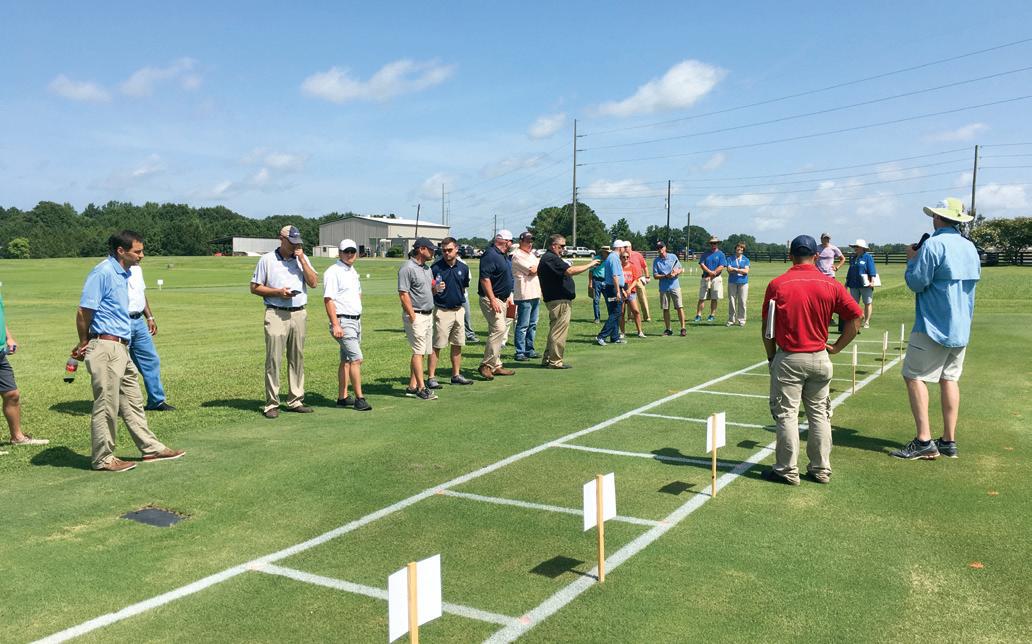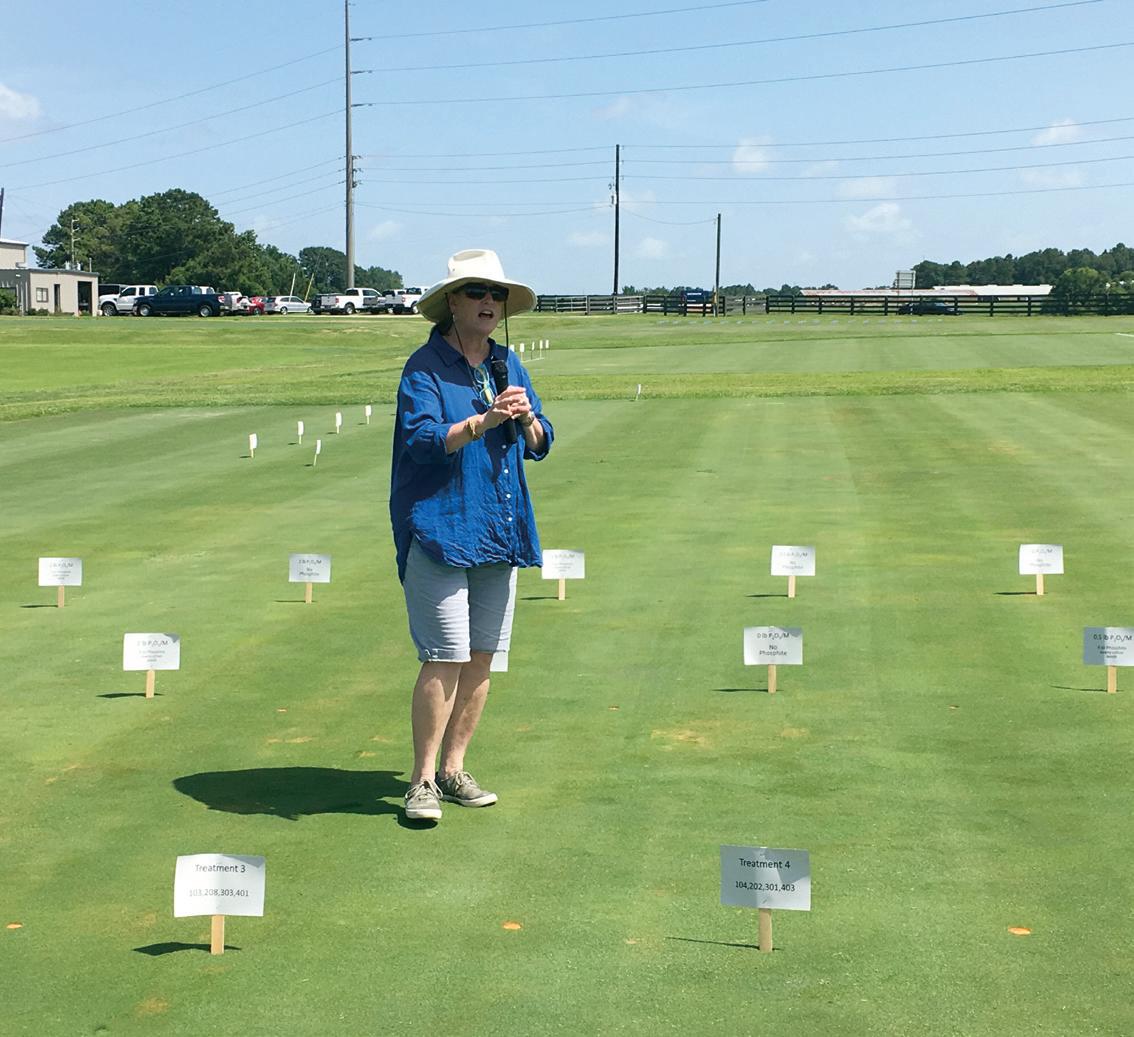
6 minute read
Auburn University Turfgrass Low-Input Field Day
A Morning of Turfgrass Research
Goals of current AU turfgrass research projects were clearly presented at the Auburn University Turfgrass Low-Input Field Day held July 16, 2019. Those attending this free event heard from Dr. Beth Guertal, Dr. Scott McElroy and Mr. Jim Harris, along with several graduate students and one industry representative as they described the projects they were involved with at the AU Turfgrass Research Unit.
Advertisement

Below is a listing of the research presented that morning with a few take-away points.
Bermuda Wear Study
Dr. Beth Guertal
This study is still ongoing with final results later this year or early 2020. The test plots have been grown-in and are receiving 4 lbs. N per year. Comments: TifTuf was drought resistant. Celebration had low input requirements during establishment.
Pylex Use in Bentgrass
Dr. Scott McElroy with Dr. Clebson Gonçalves
Pylex (Topramezone) injury increases with any of the following conditions: higher temperatures, higher rates and wet soils. This research is trying to mitigate the Pylex injury effects on bentgrass to control crabgrass during summer months. Pylex causes whitening of crabgrass chlorophyll and is very good in controlling crabgrass in bentgrass. Research shows higher injury with higher rates of Pylex, but by incorporating Iron and Plant Growth Regulators (PGR’s), less injury results.
Pylex use in Bermuda
Dr. Scott McElroy with Dr. Clebson Gonçalves
Pylex (Topramezone) will injure Bermuda grass when controlling crabgrass. To reduce injury, different PGR’s are added to the tank mix and this research has shown that certain PGR’s offer different results: highest to lowest injury are as follows: Trimmit > Primo Maxx > Cutless. Dr. Clebson Gonçalves reported that Trimmit can cause injury, especially when Bermuda is coming out of dormancy and can also thin stands of Bermuda grass.
Pre-emergent Control in Bermuda
Mr. Jim Harris
This project compares three pre-emergents for smooth crabgrass control in Bermuda. Specticle, Crew and Freehand are being tested. Crew at high rate and repeat applications gets good crabgrass control. As a side observation, a point was made that without repeat applications researchers did not see good sedge control. Also, Dr. McElroy made an interesting comment about cockscomb kyllinga. He stated that even though this species is listed as an annual, he thinks some populations have become perennial in nature.
Effects of Timing Using Manuscript (Pinoxaden) to Control Crabgrass
John Peppers
Timing the use of Manuscript is very important because past the 4–5 tiller stage of young crabgrass, Manuscript does not offer any control. Drive is better for late applications. This research tried some three way type combinations. A combination tank mix that worked was Metsulfuron (Manor), Manuscript and Adigor (a methylated rapeseed oil based adjuvant). Manuscript tanked with Halosulfuron (SledgeHammer) and Adigor showed an antagonistic effect.


Safening Manuscript (Pinoxaden) on St. Augustine
John Peppers
This research project is using certain fungicides in combination with Manuscript (Pinoxaden) to determine if any reduce herbicide injury to St. Augustine. Herbicide safeners are chemical compounds used in combination with herbicides to make them "safer" — that is, to reduce the effect of the herbicide on crop plants, and to improve selectivity between crop plants and the weed species being targeted by the herbicide. This study has compared fungicides Daconil Weatherstik and Banner Maxx, separately mixed with Manuscript. So far, it can be said that Banner Maxx reduces weed control.
Effects of Phosphite Use on P 2 O 5 Test Results
Dr. Beth Guertal
This study is testing the effects of phosphite found in many fungicides and P 2 O 5 as sources of phosphorus for turfgrass. The study compares shoot density and root depth. It was said that although phosphite can be absorbed by most plants through the leaves and/or roots, it should not be used directly as a nutrient source and therefore could not complement or substitute P 2 O 5 fertilizer at any rate. In addition, Dr. Guertal mentioned that on soil test reports, don’t worry about test results < 40 lbs/A. Only add P 2 O 5 when tests show readings of < 20 lbs/A.
Summer Safening Trial on Bentgrass
Adam Boyd with comments from Dr. Kathie Kalmowitz of BASF
This project is designed to study the summertime effects of three DMI fungicides: Torque, Maxtima and Navicon Intrinsic, when applied separately to bentgrass. The injury caused by summer heat during application alone and/or due to repeat applications will be the emphasis of this project. These are all DMI containing fungicides. Torque is labeled not to be applied over 85°F; Maxtima and Navicon Intrinsic can be applied regardless of temperature at application.
Control of Kyllinga in Bermuda
Mr. Jim Harris
Several herbicides are being evaluated for Kyllinga control including Celero, Monument, Celsius and Vanquish. These are being used alone and in tank mixes. Induce, a nonionic surfactant was also being added to some applications. Celero by itself was better in controlling Kyllinga than when tank mixed with other herbicides. As a side note, Celsius at the highest rate per acre will kill carpet grass with two applications.
Doveweed Control Using Pre-emergents
Mr. Jim Harris
Tower and Pendulum AquaCap, both pre-emergents, are being evaluated for their control of Doveweed. Two applications of Tower prevented Doveweed. However Pedulum AquaCap was also rated as good. For post-emergent control, two applications of Celsius was good at controlling Doveweed. It was mentioned that any phenoxy-type post emergent herbicide was best if made in two applications with Tower. Tank mixing Tower with MCPP was better than tank mixing with MCPA for post emergent control.


Goosegrass Biotypes Vary Greatly
Dr. Scott McElroy
Dr. McElroy has collected 11 biotypes of Goosegrass, Elusine indica. He mentioned this summer annual grassy weed is normally identified by compressed, flattened, whitish stems and tolerant of heavy traffic, dry compacted soils and low mowing heights. Dr. McElroy further stated however, that agricultural research deals with this species in different crop situations with biotypes of different size. The variability of Goosegrass biotypes with respect to growth habit is large. Dr. McElroy pointed out the differences in height and width among the 11 biotypes in his collection, drawing special attention to a very dwarf biotype collected in Texas (see photo below).

Drought Resistance of Different Bermuda Cultivars
Dr. Beth Guertal
This is a very interesting comparison of different Bermuda grass cultivars with respect to drought resistance. TifWay was developed in 1965 and is still popular but known to get stemmy during high heat and drought conditions. “It takes on a sculptured carpet look,” Dr. Guertal mentioned. Newer varieties such as TifTuf showed a higher degree of drought resistance. In fact, TifTuf could maintain acceptable appearance with only 25% to 40% of its Evapotranspiration Rate (ET) being replaced through irrigation. However, she concluded by saying that all the bermudas recovered from drought conditions.
Virginia Buttonweed and Common Lespedeza Control in Bermuda
Dr. Scott McElroy with Dr. Clebson Gonçalves
Several herbicides are being tested for Virginia Buttonweed and Lespedeza control in Bermuda. GameOn, a new herbicide released in 2018, shows good Buttonweed control at its high rate on Bermuda. It’s labeled for zoysiagrasses as well, however not for use on centipedegrass. Relzar, another new herbicide, was not so good for Buttonweed control. Certainty, Manor and Vanquish all offer good lespedeza control.
As you can see, we are very fortunate to have these fine researchers working to improve our turfgrass industry!






